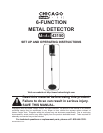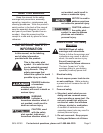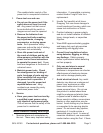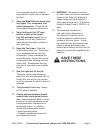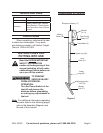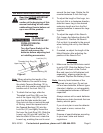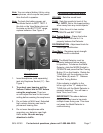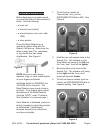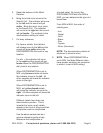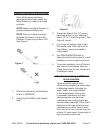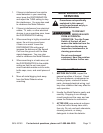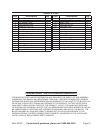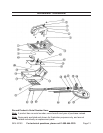
Page 6For technical questions, please call 1-800-444-3353.SKU 43150
OPERATING INSTRUCTIONS
Read the ENTIRE IMPORTANT
SAFETY INFORMATION
section at the beginning of this
manual including all text under
subheadings therein before set
up or use of this product.
Tool Set Up
TO PREVENT
SERIOUS INJURY
FROM ACCIDENTAL
OPERATION:
Turn the Power Switch of the
tool off and remove the
batteries before adjusting tool
or installing accessories.
Figure 2
Lock Nut (31)
Tapered Bushing (30)
Threaded Lock Ring (29)
Upper Leg (25)
Note: When adjusting the length of the
Metal Detector, be careful to keep
the plastic Tapered Bushing (30) in
place with the smaller end toward the
smaller end of the Lock Nut (31).
To attach the two legs, slide the 1.
Threaded Lock Ring (29) over the
end of the Upper Leg (25), making
sure that the tabs inside the Lock
Ring lock into the cut-outs at the end
of the leg. Insert the tapered end of
the Tapered Bushing (30) into the
Lock Nut (31) and lightly thread the
Nut over the Lock Ring (29). Slide the
Lower Leg (26) into the Lock Nut. To
take the slack off the cord, rotate the
Lower Leg, enabling the cord to wind
around the two Legs. Rotate the Nut
counterclockwise to lock the Legs.
To adjust the length of the Legs, turn 2.
the Lock Nut in a clockwise direction,
slide the Lower Leg to the desired
extension length and turn the Nut
counterclockwise to secure the Legs
together.
To adjust the angle of the Search 3.
Coil, loosen the Adjusting Knobs (28,
32) and tilt it. Position the Search
Coil so that it is parallel to the ground
when holding the unit by the Handle
(3, 4).
If needed, re-adjust the length of the 4.
Metal Detector after adjusting the
position of the Search Coil.
Batteries
Make sure the On/Off/Volume control 1.
is set to OFF. Slide the Battery Cover
(20) off of the back of the Control
Box and insert six AA batteries (sold
separately), aligning polarities as
indicated. Replace the Battery Cover.
Note: Use only fresh batteries of the
required size and type. Do not mix
old and new batteries, different types
(standard, alkaline, or rechargeable),
or rechargeable batteries of different
capacities.
Always remove old or weak batteries.
Batteries can leak chemicals that can
destroy electric parts.
If you do not plan to use the detector
for a week or more, remove the
batteries.
Dispose of spent batteries according
to your local, state and federal
regulations.



